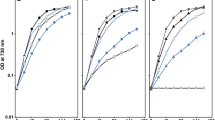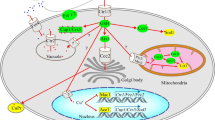Abstract
Cold shock proteins (CSPs) have a widespread occurrence from prokaryotes to eukaryotes including plants. These proteins are known to possess nucleic acid binding properties. CSPs have a single cold shock domain in prokaryotes while N-terminal and C-terminal flanking regions are present in eukaryotic CSPs. The objective of this study was to investigate nucleic acid binding preferential for the chickpea CSP. Full cDNA of chickpea CSP was cloned and sequenced. The sequence was submitted to GenBank (accession no. KM036036) at NCBI. Multiple sequence alignment and phylogenetic analysis further revealed that the inferred amino acid sequence belongs to CSP family. Molecular docking was performed between the CSP and variety of nucleic acids entities. These results suggest that CSPs of chickpea possess preferential binding affinity for single stranded nucleic acids. Docking results suggest that homo-polymer entities of RNA polyU RNA (20mer) form most stable complex.



Similar content being viewed by others
References
Adkins S, Burmeister M (1996) Visualization of DNA in agarose gels and educational demonstrations. Anal Biochem 240(1):17–23
Chaikam V, Karlson D (2008) Functional characterization of two cold shock domain proteins from Oryza sativa. Plant Cell Environ 31:995–1006. doi:10.1111/j.1365-3040.2008.01811.x
Clark JM (1988) Novel non-templated nucleotide addition reactions catalyzed by prokaryotic and eukaryotic DNA polymerases. Nucleic Acids Res 16(20):9677–9686
de Vries SJ, Bonvin AMJJ (2010) The HADDOCK web server for data-driven biomolecular docking. Nat Protoc 5:883–897
Evdokimova VM, Ovchinnikov LP (1999) Translational regulation by Y-box transcription factor: involvement of the major mRNA-associated protein, p50. Int J Biochem Cell Biol 31:139–149
Fiser A, Sali A (2003) ModLoop: automated modeling of loops in protein structures. Bioinformatics 19:2500–2501
Fiser A, Do RKG, Sali A (2000) Modeling of loops in protein structures. Prot Sci 9:1753–1773
Goldstein J, Pollitt NS, Inouye M (1990) Major heat shock protein of Escherichia coli. Proc Natl Acad Sci USA 87:283–287
Guy CL (1990) Cold acclimation and freezing stress tolerance: role of protein metabolism. Annu Rev Plant Physiol Plant Mol Biol 41:187–223
Izumi H, Imamura T, Nagatani G, Ise T, Murakami T, Uramoto H, Torigoe T, Ishiguchi H, Yoshida Y, Nomoto M, Okamoto T, Uchiumi T, Kuwano M, Funa K, Kohno K (2001) Y box-binding protein-1 binds preferentially to single-stranded nucleic acids and exhibits 3′ → 5′ exonuclease activity. Nucleic Acids Res 29:1200–1207. doi:10.1093/nar/29.5.1200
Jones PG, Inouye M (1994) The cold-shock response-a hot topic. Mol Microbiol 11:811–818
Karlson D, Imai R (2003) Conservation of the cold shock domain protein family in plants. Plant Physiol 131:12–15
Karlson D, Nakaminami K, Toyomasu T, Imai R (2002) J Biol Chem 277:35248–35256
Kim MH, Sasaki K, Imai R (2009) Cold shock domain protein 3 regulates freezing tolerance in Arabidopsis thaliana. J Biol Chem 284:23454–23460. doi:10.1074/jbc.M109.000752
Larkin MA, Blackshields G, Brown NP, Chenna R, McGettigan PA, McWilliam H, Valentin F, Wallace IM, Wilm A, Lopez R, Thompson JD, Gibson TJ, Higgins DG (2007) Clustal W and Clustal X version 2.0. Bioinformatics 23(21):2947–2948
Mani A, Gupta DK (2014) Single-stranded nucleic acid binding in Arabidopsis thaliana cold shock protein is cold shock domain dependent. J Biomol Struct Dyn 33:861–868. doi:10.1080/07391102.2014.907747
Mani A, Yadava PK, Gupta DK (2012) Cold shock domain protein from Philosamia ricini prefers single stranded nucleic acid binding. J Biomol Struct Dyn 30:532–541. doi:10.1080/07391102.2012.687519
Mantri NL, Ford R, Coram TE, Pang ECK (2007) Transcriptional profiling of chickpea genes differentially regulated in response to high-salinity, cold and drought. BMC Genom 8:303. doi:10.1186/1471-2164-8-303
Nakaminami K, Sasaki K, Kajita S, Takeda H, Karlson D, Ohgi K, Imai R (2005) Heat stable ssDNA/RNA-binding activity of a wheat cold shock protein. FEBS Lett 579:4887–4891
Nakaminami K, Karlson DT, Imai R (2006) Functional conservation of cold shock domains in bacteria and higher plants. Proc Natl Acad Sci USA 103:10122–10127
Nakaminami K, Hill K, Perry SE, Sentoku N, Long JA, Karlson DT (2009) Arabidopsis cold shock domain proteins: relationships to floral and silique development. J Exp Bot 60:1047–1062
Rand KN (1996) Crystal violet can be used to visualize DNA bands during gel electrophoresis and to improve cloning efficiency. Elsevier Trends Journals Technical Tips, Online, T40022
Roy A, Kucukural A, Zhang Y (2010) I-TASSER: a unified platform for automated protein structure and function prediction. Nat Protoc 5:725–738
Saitou N, Nei M (1987) The neighbor-joining method: a new method for reconstructing phylogenetic trees. Mol Biol Evol 4(4):406–425
Sanghera GS, Wani SH, Hussain W, Singh Nb (2011) Engineering cold stress tolerance in crop plants. Curr Genomics 12:30–43. doi:10.2174/138920211794520178
Sasaki K, Imai R (2012) Pleiotropic roles of cold shock domain proteins in plants. Front Plant Sci 2:116. doi:10.3389/fpls.2011.00116
Sasaki K, Kim MH, Imai R (2013) Arabidopsis COLD SHOCK DOMAIN PROTEIN 2 is a negative regulator of cold acclimation. New Phytol 198:95–102
Tamura K, Peterson D, Peterson N, Stecher G, Nei M, Kumar S (2011) MEGA5: molecular evolutionary genetics analysis using maximum likelihood, evolutionary distance, and maximum parsimony methods. Mol Biol Evol 28:2731–2739
Thieringer HA, Jones PG, Inouye M (1998) Cold shock and adaptation. BioEssays 20(1):49–57
Wiame I et al (2000) Irreversible heat inactivation of DNaseI without RNA degradation. Biotechniques 29:252–256
Xin Z, Browse J (2001) Cold comfort farm: the acclimation of plants to freezing temperatures. Plant Cell Environ 23:893–902
Yadav BS, Singh S, Mani A (2015) Structure prediction and docking based molecular insights of human YB-1 and nucleic acid interaction. J Biomol Struct Dyn. doi:10.1080/07391102.2015.1124050
Yang J, Roy A, Zhang Y (2013a) BioLiP: a semi-manually curated database for biologically relevant ligand–protein interactions. Nucleic Acids Res 41:D1096–D1103
Yang J, Roy A, Zhang Y (2013b) Protein–ligand binding site recognition using complementary binding-specific substructure comparison and sequence profile alignment. Bioinformatics 29:2588–2595
Yang J, Yan R, Roy A, Xu D, Poisson J, Zhang Y (2015) The I-TASSER Suite: protein structure and function prediction. Nat Methods 12:7–8
Zhang Y (2008) I-TASSER server for protein 3D structure prediction. BMC Bioinform 9:40
Acknowledgments
PB is thankful to MNNIT Allahabad for a M. Tech Fellowship. BSY is thankful to DST, New Delhi for PhD fellowship. SS is thankful to UGC New Delhi for a PhD fellowship. AM is thankful to TEQIP II for a project grant.
Author information
Authors and Affiliations
Corresponding author
Ethics declarations
Conflict of interest
None of the authors have any conflict of interests.
Electronic supplementary material
Below is the link to the electronic supplementary material.
Rights and permissions
About this article
Cite this article
Bhadauriya, P., Yadav, B.S., Singh, S. et al. Binding preferential of chickpea cold shock protein during nucleic acid interactions. J. Plant Biochem. Biotechnol. 26, 208–215 (2017). https://doi.org/10.1007/s13562-016-0383-5
Received:
Accepted:
Published:
Issue Date:
DOI: https://doi.org/10.1007/s13562-016-0383-5




